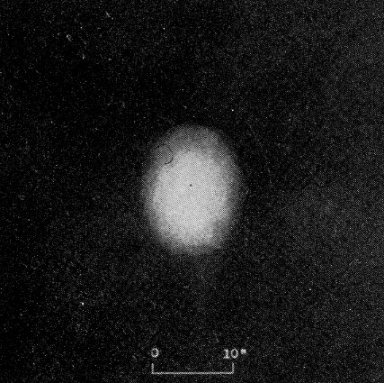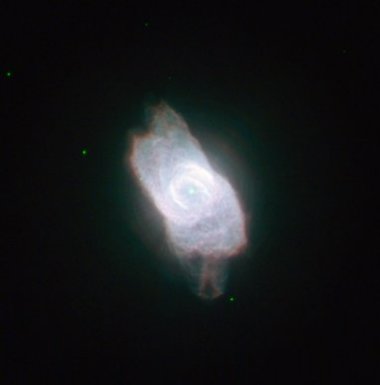NGC 6572
"An oval disk, fading slightly out toward the edges. No structural
details visible. Exceedingly bright." [Curtis]. NGC 6818 (the
"Blue Racquetball" to some) lies in far northeastern Ophiuchus about 5 degrees north-northeast
of the vee-shaped asterism known as Poniatowski's Bull. One of the brightest
planetary nebulae
in the sky, NGC 6572's compactness and small size (averaging about
14 seconds of arc in diameter) precludes visual observation of the
intricate detail seen in the Hubble image (north up and to the
left), with its central interlocking rings surrounded by fainter
symmetrical lobes. Were it not for intervening interstellar dust,
the nebula would be twice as bright.
Distance estimates range from 1400 to 6400 light years. The best
value, found from the angular expansion (against a true expansion
rate of some 16 kilometers per second), is 4900 light years, which
would make NGC 6572 a third of a light year across. Though
obscured by the nebular brightness, the 13th magnitude (12.9)
central star is still visible (and was observed by Curtis). A
temperature of 60 to 65 thousand Kelvin and a luminosity of 1200
Suns (found by comparing the nebular and stellar brightnesses)
suggest a low mass of some 0.55 times that of the Sun, which is consistent with a lack of
chemical enrichment of the nebula (which requires higher mass).
The nebular nucleus, which is still heating toward a maximum of
about 100,000 Kelvin before it begins to cool and dim, must have
started life with a mass not that much different from solar. When
the nebula dissipates, it will appear as an ordinary, low-mass white dwarf.
Left: Image by H. D. Curtis from Publications of the Lick
Observatory, Volume 13, Part III, 1918. Right: ESA/Hubble and
NASA.



